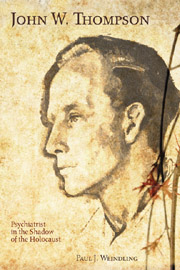Book contents
- Frontmatter
- Contents
- List of Illustrations
- Acknowledgments
- List of Abbreviations
- Part One Into the Dark
- 1 “Ecce Homo”
- 2 Mexican Childhood
- 3 Palo Alto Schooling, Stanford Student
- 4 Transatlantic Physiologist
- 5 Edinburgh Physician
- 6 Excitable Harvard
- 7 High Altitude and Rapid Descent
- 8 Auden, Anxiety, and the German Mind
- Part Two Redemption
- Part Three Aftermath
- Appendix John Thompson's Writings
- Notes
- Sources
- Index
3 - Palo Alto Schooling, Stanford Student
from Part One - Into the Dark
Published online by Cambridge University Press: 12 September 2012
- Frontmatter
- Contents
- List of Illustrations
- Acknowledgments
- List of Abbreviations
- Part One Into the Dark
- 1 “Ecce Homo”
- 2 Mexican Childhood
- 3 Palo Alto Schooling, Stanford Student
- 4 Transatlantic Physiologist
- 5 Edinburgh Physician
- 6 Excitable Harvard
- 7 High Altitude and Rapid Descent
- 8 Auden, Anxiety, and the German Mind
- Part Two Redemption
- Part Three Aftermath
- Appendix John Thompson's Writings
- Notes
- Sources
- Index
Summary
Paly High
John and his elder brother Philip attended Palo Alto Union High School beginning on September 13, 1920. “Paly High” was modern, progressive, and coeducational. Stanford's imposing first chancellor, David Starr Jordan, laid the cornerstone for the Spanish colonial-style school buildings in 1918, and his progressive spirit—democratic, pacifist, conservationist, and eugenicist—permeated its ethos. Paly High aimed to inculcate values of citizenship, community, social responsibility, and hygiene. It had energetic, first-class teachers. Reinhold John Jungermann, who taught biological science, had students evaluate the quality of his courses.
The burly, determined Philip was “a natural leader”: he was class president in 1924 and captained the Block P Society, made up of Paly High's academic and sports elite. As president, he initiated a constitution to create a spirit of honor and stamp out cheating. John excelled in team sports, notably football, and was the school commissioner for athletics.
John was also a Block P letterman and was more modestly involved in soccer and basketball. A photo—a rarity, as he evaded the formal year group photos in the Paly High and university yearbooks—shows him as a lithe “basketeer.” He was secretary-treasurer of Freshman Class 9B in 1921.
Paly High held a lively round of dramatics, Orpheans' cabarets, and choral concerts. Students danced to “Old King Jazz,” the Charleston, and the black bottom. A crisis occurred at carnival time when John, the student commissioner for entertainment, played the femme fatale “Lady Lou” in the Yukon gold-rush melodrama The Shooting of Dan McGrew, on April 13, 1923. He stepped out of line for bringing an unchaperoned ex-student to the dance. He used the carnival burlesque to challenge restrictive sexual conventions.
- Type
- Chapter
- Information
- John W. ThompsonPsychiatrist in the Shadow of the Holocaust, pp. 17 - 23Publisher: Boydell & BrewerPrint publication year: 2010



